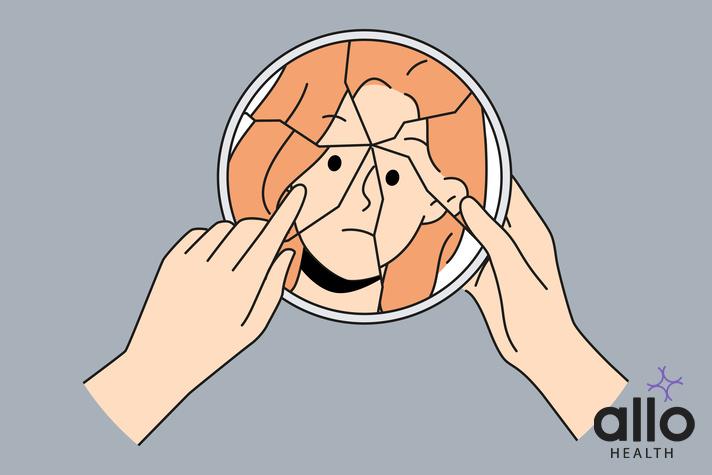Impact of Sexualisation on Girls’ Sexuality

Allo Health is dedicated to personalized well-being, offering support and trusted information tailored to individual health goals. The platform emphasizes human-generated content, led by a distinguished medical team of experts, including physicians and sexual health specialists. Their commitment to credibility involves rigorous fact-checking, authoritative research, and continuous updates to ensure accurate, up-to-date information. Allo Health's unique approach goes beyond conventional platforms, providing expert-led insights and a continuous commitment to excellence, with user feedback playing a crucial role in shaping the platform's authoritative voice.

Dr. Aditi completed her undergraduate medical education at AJIMS, Mangalore, after which she worked in multi-speciality hospitals with COVID patients and in the Pain and Palliative medicine department. Driven by her experiences, she developed a keen interest in psychiatry. Dr. Aditi believes that mental health is just as, if not more important, than physical health.
Why This Was Upated?
Our experts continually monitor the health and wellness space, and we update our articles when new information became available.
Updated on 08 April, 2024
- Article was updated as part of our commitment to diversity, equity, and inclusion.

"The following blog article provides general information and insights on various topics. However, it is important to note that the information presented is not intended as professional advice in any specific field or area. The content of this blog is for general educational and informational purposes only.
Book consultation
The content should not be interpreted as endorsement, recommendation, or guarantee of any product, service, or information mentioned. Readers are solely responsible for the decisions and actions they take based on the information provided in this blog. It is essential to exercise individual judgment, critical thinking, and personal responsibility when applying or implementing any information or suggestions discussed in the blog."
In today’s hyper-sexualized media landscape, it’s hard to avoid images and messages that sexualize young girls. From music videos to advertising campaigns, girls are inundated with often unrealistic and harmful portrayals of what it means to be feminine. But what exactly is sexualization, and how does it impact young girls’ sexuality, self-image, and behavior?
What Is Sexuality?
Sexuality is a complex and multifaceted aspect of human identity that encompasses a range of feelings, attractions, behaviors, and preferences related to one’s emotional, romantic, and sexual desires. It’s an integral part of being human and can have a significant influence on individual relationships, self-concept, and overall well-being. Sexuality is not solely about sexual orientation; it includes a broader spectrum of experiences.
Here are some key components of sexuality:
- Sexual Orientation: This refers to an individual’s emotional, romantic, and sexual attraction to people of the same gender (homosexuality), opposite gender (heterosexuality), both genders (bisexuality), or neither gender (asexuality). Sexual orientation is considered to be a natural and enduring aspect of a person’s identity and is not something that can be changed.
- Gender Identity: Gender identity refers to a person’s internal sense of their own gender, whether it aligns with the sex they were assigned at birth or not. Some people identify as cisgender, meaning their gender identity matches their assigned sex, while others identify as transgender, meaning their gender identity differs from their assigned sex. Gender identity is closely related to but distinct from sexuality.
- Romantic Orientation: This is the emotional and romantic attraction a person experiences towards others. It may or may not align with their sexual orientation. For instance, someone may identify as homosexual in terms of sexual attraction but as biromantic in terms of romantic attraction.
- Erotic Orientation: This aspect refers to the specific types of activities, fantasies, and stimuli that elicit sexual arousal and pleasure in an individual. These preferences can vary widely from person to person.
- Attraction: Attraction can be categorized into several forms, including physical, emotional, and intellectual attraction. These attractions contribute to a person’s overall sense of connection and compatibility with others.
- Sexual Behavior: This includes the actions and behaviors individuals engage in to express their sexual desires and feelings. It can range from intimate conversations and affectionate gestures to sexual intercourse.
- Sexual Expression: This involves how individuals choose to express their sexuality, whether through their clothing, mannerisms, communication style, or other means. Cultural and societal factors often play a role in shaping how people express their sexuality.
- Sexual Health and Education: Understanding one’s own body, practicing safe sex, and having access to comprehensive sexual education are crucial components of maintaining a healthy and fulfilling sexual life.
- Social and Cultural Context: Sexuality is influenced by cultural, societal, and religious norms and values. These factors can shape people’s beliefs, attitudes, and behaviors related to sexuality.
- Fluidity and Exploration: For many people, sexuality is not fixed and can evolve over time. Some individuals may experience changes in their attractions or preferences, and some may engage in self-discovery and exploration to better understand their own desires.
Everyone’s experience of their own sexuality is unique. People may experience internal conflicts, societal pressures, and discrimination based on their sexual orientation or gender identity. Supportive communities, open communication, and access to accurate information can contribute to a more inclusive and understanding approach to sexuality.
What Is Sexualisation?
Sexualization refers to the process of portraying or treating an individual or object in a sexual manner, often without regard for their thoughts, feelings, or humanity, and primarily focusing on their sexual appeal or attributes. It involves emphasizing sexual characteristics, innuendos, and eroticism, sometimes in a way that objectifies the person or object in question. Sexualization can occur in various contexts, including media, advertising, art, and interpersonal interactions. It’s important to differentiate between healthy expressions of sexuality and the harmful effects of sexualization.
Here are some key points to understand about sexualization:
- Objectification: One of the most significant concerns related to sexualization is objectification. Objectification occurs when a person is reduced to their physical appearance or sexual attributes, often disregarding their personality, emotions, and humanity. This can lead to the devaluation of individuals as whole beings, reinforcing harmful power dynamics and contributing to a culture that objectifies people based on their bodies.
- Media and Advertising: The media and advertising industries often use sexualized imagery and messages to sell products, attract attention, and engage audiences. This can lead to unrealistic beauty standards, promote the idea that a person’s worth is tied to their appearance, and perpetuate harmful stereotypes.
- Impact on Individuals: Constant exposure to sexualized images and messages can impact individuals’ self-esteem, body image, and overall well-being. It can create feelings of inadequacy, shame, and anxiety, especially when people feel they don’t meet the perceived ideal of attractiveness.
- Children and Adolescents: The sexualization of children and adolescents is a particularly concerning concern. Exposure to sexualized content at a young age can negatively influence their development, self-concept, and understanding of healthy relationships.
- Gender and Diversity: Sexualization often reinforces traditional gender roles and can contribute to a lack of representation and inclusion of diverse bodies and identities in media and society. It can also perpetuate harmful stereotypes and biases.
- Consent and Boundaries: Sexualization can blur the lines between appropriate and inappropriate behavior, making it important to establish and respect boundaries in interpersonal interactions. It’s crucial to recognize and prioritize consent and the agency of individuals.
- Sexual Expression vs. Sexualization: It’s important to distinguish between healthy sexual expression and sexualization. Healthy sexual expression involves mutual consent, respect, and a focus on the emotional and physical well-being of all parties involved. Sexualization, on the other hand, tends to emphasize one-sided sexual appeal and can often be objectifying.
- Media Literacy: Developing media literacy skills is essential for recognizing and critiquing instances of sexualization. Being able to critically analyze media messages and representations can empower individuals to make informed choices and challenge harmful norms.
Efforts to address sexualization include promoting media literacy education, advocating for more diverse and inclusive representation in media, and encouraging conversations about healthy sexuality, consent, and the impact of sexualized content on individuals and society.
What Is The Difference Between Sexuality And Sexualisation?
Sexuality and sexualization are related concepts, but they have distinct meanings and implications:
- Sexuality: Sexuality refers to a broad and intrinsic aspect of human identity that encompasses an individual’s emotional, romantic, and sexual attractions, desires, orientations, behaviors, and preferences. It encompasses a wide range of feelings and experiences related to one’s sexual orientation, gender identity, romantic attractions, and intimate relationships. Sexuality is a natural and integral part of being human and varies from person to person.
- Sexualization: Sexualization, on the other hand, refers to the process of portraying or treating individuals or objects in a sexual manner, often emphasizing their sexual attributes or appeal while disregarding their thoughts, feelings, and humanity. This can involve using explicit imagery, innuendos, or sexual content to objectify individuals or present them primarily as sexual objects. Sexualization can occur in media, advertising, art, or interpersonal interactions and can have negative effects on self-esteem, body image, and overall well-being.
Key Differences:
- Focus:
- Sexuality focuses on an individual’s internal experiences, emotions, attractions, and relationships. It encompasses the full range of a person’s sexual and romantic identity.
- Sexualization focuses on external portrayal and presentation, emphasizing sexual appeal or attributes without necessarily considering the individual’s personality, emotions, or identity.
- Nature:
- Sexuality is a natural and essential aspect of human existence that contributes to a person’s identity and overall well-being.
- Sexualization involves objectifying individuals or objects and often contributes to unrealistic beauty standards, harmful stereotypes, and negative impacts on self-perception.
- Intent:
- Sexuality is a personal and intrinsic aspect of an individual’s identity that involves genuine feelings and attractions.
- Sexualization often involves external actors (such as media, advertising, or individuals) intentionally emphasizing sexual aspects for various reasons, which may include attention, shock value, or profit.
- Agency and Consent:
- Sexuality involves an individual’s agency, self-awareness, and autonomy in expressing their desires and forming healthy relationships.
- Sexualization can sometimes involve the disregard of an individual’s agency and boundaries, potentially leading to objectification and reinforcing harmful power dynamics.
- Positive vs. Negative Impact:
- Sexuality, when expressed and experienced in a healthy and consensual manner, can contribute positively to an individual’s well-being and relationships.
- Sexualization, especially when objectifying or harmful, can have negative impacts on self-esteem, body image, and psychological health.
Impact Of Sexualisation With Women

The sexualization of women is a pervasive concern that has profound social, psychological, and cultural impacts. It involves reducing women to their physical appearance and sexual attributes, often without regard for their intelligence, abilities, or humanity. This can occur in various contexts, including media, advertising, entertainment, and daily interactions. The impact of sexualization on women is complex and multifaceted:
- Body Image and Self-Esteem: The portrayal of unrealistic beauty standards and sexualized images in media can negatively impact women’s body image and self-esteem. Constant exposure to these images can create feelings of inadequacy and contribute to a sense of never being able to meet the idealized physical standards.
- Objectification: Sexualization often leads to objectification, where women are seen as objects for others’ sexual pleasure rather than as complex individuals with thoughts, feelings, and agency. This can contribute to a devaluation of women’s autonomy and reinforce harmful power dynamics.
- Psychological Well-Being: The constant pressure to conform to sexualized ideals can lead to anxiety, depression, and other mental health concerns. Women may feel the need to continuously evaluate and alter their appearance to fit societal norms, leading to stress and dissatisfaction.
- Reduced Sense of Self-Worth: When women are predominantly valued for their sexual appeal, their other qualities, skills, and accomplishments can be overshadowed. This can lead to a reduced sense of self-worth and discourage women from pursuing their goals and aspirations beyond appearance-related pursuits.
- Relationships and Intimacy: Sexualization can influence women’s perceptions of relationships and intimacy. It may contribute to the objectification of women in romantic and sexual contexts, making it challenging to establish healthy, equal, and respectful partnerships.
- Social and Professional Impact: The sexualization of women can impact their social interactions and professional opportunities. Women may be judged based on their appearance rather than their skills, knowledge, or abilities, which can hinder their advancement in various fields.
- Normalization of Harmful Norms: Sexualized portrayals of women can normalize harmful gender norms, such as the idea that a woman’s primary value lies in her attractiveness. This can perpetuate gender inequalities and reinforce stereotypes.
- Sexual Harassment and Violence: The objectification resulting from sexualization can contribute to a culture where sexual harassment and violence are more likely to occur. It can contribute to the normalization of disrespectful behaviors and a lack of understanding of consent.
- Impact on Youth: The sexualization of women is especially concerning for young girls who are exposed to these messages at an early age. This can influence their development, self-concept, and understanding of healthy relationships.
- Cultural and Societal Impact: The pervasive sexualization of women in media and culture can contribute to a society where women are primarily seen as objects for consumption. This perpetuates a culture that prioritizes appearance over substance.
Addressing the impact of sexualization on women requires efforts on multiple fronts, including media literacy education, promoting diverse and realistic representations of women, challenging harmful stereotypes, and fostering environments that value women for their full range of qualities and contributions. Empowering women to embrace their authentic selves and cultivating a culture of respect and equality are essential steps in mitigating the negative effects of sexualization.
Frequently Asked Questions
(1) What is girls’ sexuality?
Girls’ sexuality refers to their emotional, romantic, and sexual feelings, attractions, and behaviors. Just like boys, girls experience a wide range of desires and orientations that contribute to their identity and relationships.
(2) What is sexualization of girls?
Sexualization of girls involves portraying them in a sexualized manner that emphasizes their physical appearance, often without considering their thoughts, feelings, or humanity. This can contribute to unrealistic beauty standards and harm their self-esteem.
(3) How does media impact girls’ sexuality?
Media can influence girls’ perception of beauty and relationships. Unrealistic images can lead to body dissatisfaction, while sexualized portrayals may impact their understanding of healthy relationships and consent.
(4) What are the effects of sexualization on girls?
Sexualization can harm girls’ self-esteem, body image, and psychological well-being. It can also contribute to objectification, impact relationships, and normalize harmful gender norms.
(5) How can parents address the impact of sexualization?
Parents can foster open communication, encourage critical media consumption, and promote healthy self-image. Creating a safe space for discussions about consent, relationships, and self-worth is crucial.
(6) What role does education play?
Comprehensive sex education can empower girls to understand their bodies, make informed choices, and cultivate healthy relationships. It can also help them recognize and challenge harmful norms.
(7) How does the sexualization of girls affect boys?
The sexualization of girls can contribute to distorted perceptions of relationships and consent among boys. It’s important to educate boys about respect, equality, and healthy attitudes toward girls’ autonomy.
(8) What’s the link between sexualization and self-objectification?
Sexualization can lead to self-objectification, where girls internalize the view of themselves as objects for others’ pleasure. This can impact self-esteem and well-being.
(9) How can society promote positive change?
Society can encourage diverse and realistic representations of girls, challenge media that sexualizes them, and support initiatives that empower girls to express their identity authentically.
(10) How can girls reclaim their sexuality?
Girls can reclaim their sexuality by prioritizing their feelings, autonomy, and well-being. They can challenge societal pressures, cultivate positive self-image, and build relationships based on respect and equality.






































